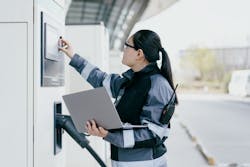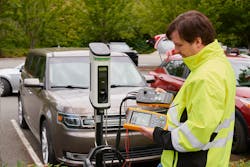The projected growth of electric vehicles (EVs) on U.S. roads is expected to reach 22 million by 2030. With that dramatic increase in the number of vehicles comes an equally dramatic increase in demand for reliable EV supply equipment (EVSE) infrastructure.
Already, EV charging stations are cropping up around shopping malls, big-box retailers, and grocery stores, allowing EV owners to charge their cars while shopping. Yet, once you get out of urban areas and onto interstate highways, the availability of EV charging stations declines sharply. There aren’t nearly enough charging stations to serve the wave of demand that’s about to break over the next decade — and the stations that exist may or may not be fully functional when you drive up (Photo 1). This creates “range anxiety” for EV drivers, who worry about keeping their vehicles charged on long-distance trips.
Availability and reliability are key to building a successful EV infrastructure, and reducing servicing costs is critical to increasing both (Photo 2). EVSE station owners and operators need to be able to build, operate, and maintain EV charging stations cost effectively. Meanwhile, drivers need confidence that when they drive into an EV station, they’ll find working chargers. Charging station reliability has been a big issue since the early days of EVs, largely due to a lack of preventive maintenance and slow response time for fixing outages.
Reduce costs and increase reliability
One way to reduce EVSE service costs — and increase reliability — is to streamline inspections so that EVSE manufacturers and station owners can commit to a regular, proactive program of preventive maintenance. Proper maintenance helps minimize downtime, which reduces lost revenue from non-functional chargers. Regular maintenance can also help reduce replacement costs by maximizing the useful life of charging equipment.
Some EVSE manufacturers already offer total care plans that guarantee a certain level of uptime for their equipment; this will likely become a wider standard as time goes on. A big challenge to implementing those plans is the shortage of labor trained to troubleshoot and maintain EVSE installations. That challenge creates new opportunities and revenue streams for local electrical professionals to install, certify, and maintain the equipment.
Streamline EVSE maintenance and troubleshooting
To make EVSE preventive maintenance more cost-effective and efficient, new tools are available that streamline the inspection process, thus reducing the time and labor required for maintenance and troubleshooting.
A typical preventive maintenance protocol for an EV charger includes cleaning the cables, connectors, and filters and then checking operability. In the past, the charger operability testing required connecting an actual EV to the charger to see whether the unit was working. This required moving the EV from charger to charger. If the charging sequence didn’t start, there was no easy way to tell whether the problem was with the charger or with the vehicle.
Now a handheld tool called an EV adapter can simulate the control pilot charging state of an electric vehicle and automate several safety and functionality tests — with no EV required. The technician simply connects the adapter to a charging port and runs a protective earth pre-test grounding safety check to make sure the station is wired correctly and that the protective earth is functioning. Some simulators also include a ground-fault circuit interrupter (GFCI) function test to ensure the GFCI will trip when necessary. With a simulator, the average testing would take 10 to 15 minutes per charger.
With this type of tool in their arsenal, electricians can delegate monthly preventive maintenance inspections to a technician who has completed 5 to 10 hours of EVSE training. If everything checks out, the charger is good for another month. If technicians find a problem that needs more extensive evaluation, they can call in a licensed electrician to diagnose and fix the problem. This reduces average servicing costs, making it more practical for EVSE station owners and operators to commit to a regular preventive maintenance program. It also frees up electricians to address problems that require more expertise and produce more revenue.
Expand opportunities for licensed electricians
An EV adapter gives electricians a troubleshooting head start by quickly identifying the most common problems (Photo 3). Once the problem is identified, electricians can connect more advanced tools to get to the root cause. For example, they can simulate multiple charging states with the EV adapter and connect a digital multimeter to verify voltage transfer from the charger to the EV in each charging state. They can also simulate PE and CP ground fault errors and verify on the digital multimeter that the voltage from the charging station to the EV cuts off when those occur.
For more advanced testing, electricians can connect other test tools (such as portable oscilloscopes and power quality testers) to an EV adapter to assess insulation resistance, power quality, waveform, and loop impedance analyses, among other measures.
Efficient use of professional resources
The ability to delegate EVSE preventive maintenance to skilled technicians can create a predictable revenue stream for electrical contractors while also extending the capacity of licensed electricians to handle more complex projects. At the same time, this approach can significantly reduce inspection costs, thus committing to preventive maintenance programs more financially attractive to EVSE operators and owners. The result is a more reliable EVSE infrastructure that gives EV drivers confidence they’ll be able to charge their vehicles wherever they drive.
The accelerating growth of the EV market is creating many interesting opportunities for electrical professionals to expand into EVSE support. I encourage anyone interested in getting into EVSE installation, troubleshooting, and/or maintenance to do some research.
Some places to start include the Electric Vehicle Infrastructure Training Program (EVITP) and regional programs like Clean Tech Institute. Talk to EVSE manufacturers and local electric utilities about EVSE certification training resources. Find out about the variety of EVs available, and drive a few. Start now, and become part of the growing EVSE infrastructure where you are — you never know where it will take you.
Rue Phillips is a recognized leader and veteran in solar, electric vehicle (EV), and renewable technologies who has created and run numerous companies in the cleantech space. As a sought-after industry expert, Rue is a frequent event keynote and technical speaker, and he serves on expert advisory committees for the development of codes and standards for the U.S. renewable energy industry. He’s also the host of the popular podcast “EV Chat,” as well as the community founder and director for the LinkedIn group EV Infrastructure Forum. This article was written on behalf of Fluke Corp.
About the Author
Rue Phillips
Rue Phillips, of 365 Pronto, is a recognized leader and veteran in solar, electric vehicle (EV), and renewable technologies who has created and run numerous companies in the cleantech space. As a sought-after industry expert, Rue is a frequent event keynote and technical speaker, and he serves on expert advisory committees for the development of codes and standards for the U.S. renewable energy industry. He’s also the host of the popular podcast “EV Chat” as well as the community founder and director for the LinkedIn group EV Infrastructure Forum.



